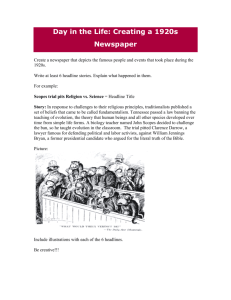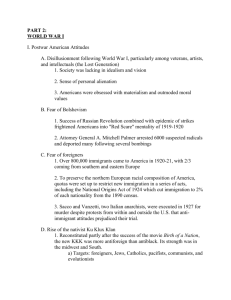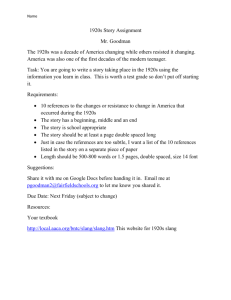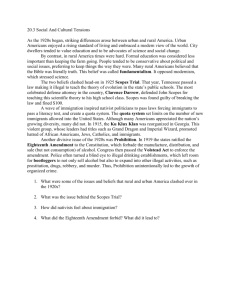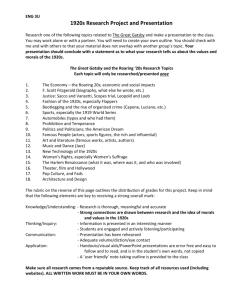1920s study guide
advertisement
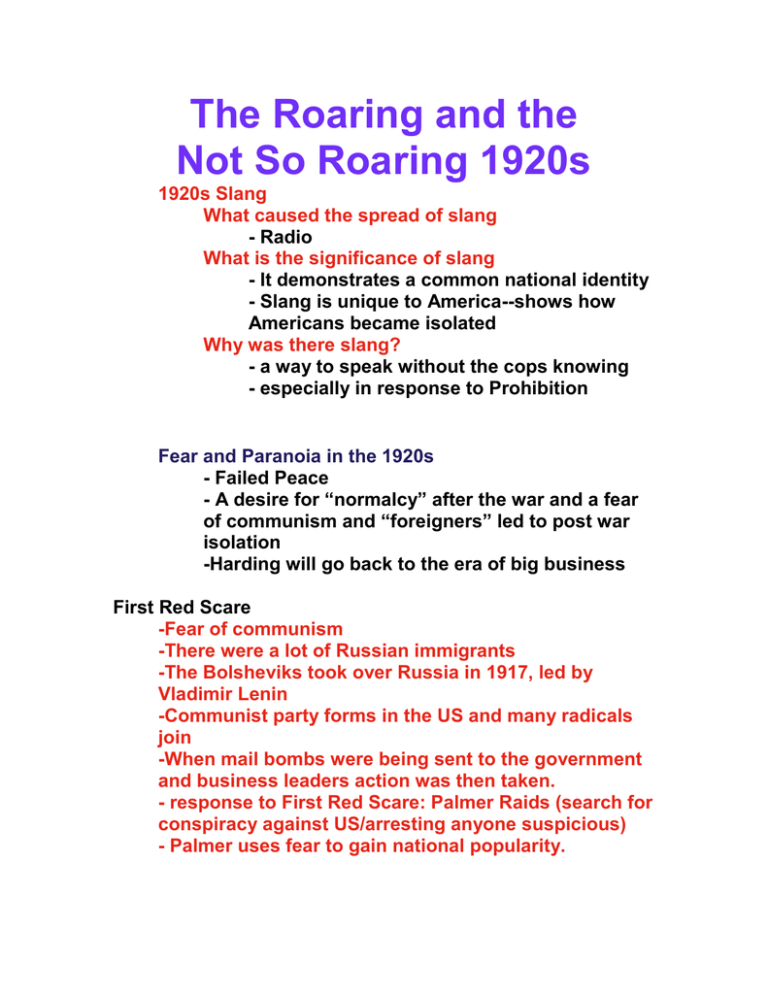
The Roaring and the Not So Roaring 1920s 1920s Slang What caused the spread of slang - Radio What is the significance of slang - It demonstrates a common national identity - Slang is unique to America--shows how Americans became isolated Why was there slang? - a way to speak without the cops knowing - especially in response to Prohibition Fear and Paranoia in the 1920s - Failed Peace - A desire for “normalcy” after the war and a fear of communism and “foreigners” led to post war isolation -Harding will go back to the era of big business First Red Scare -Fear of communism -There were a lot of Russian immigrants -The Bolsheviks took over Russia in 1917, led by Vladimir Lenin -Communist party forms in the US and many radicals join -When mail bombs were being sent to the government and business leaders action was then taken. - response to First Red Scare: Palmer Raids (search for conspiracy against US/arresting anyone suspicious) - Palmer uses fear to gain national popularity. Limitations on Immigration - Nativism-prejudice against foreign born people - The national origins act of 1924: established immigration quotas that discriminated strongly against people from outside Western Europe. (antiCatholic, anti Judaism) - limited the amount of foreigners could come to America - contrasting to the previous decade when Ellis Island was open to immigrants - Foreign born radicals were deported without trial - Xenophobic (anti-foreigner) Nativism/KKK - Return of the KKK- Ignorant people used anticommunism as an excuse to harass groups unlike themselves. They only liked people who were white, protestants, and Anglo-Saxon(British). Anti Catholic/Anti Black/Anti Jewish - Nativist-people who have been in America so long that they feel they are true Americans not immigrants. They feel they have the rights/only American sentiment Xenophobia - irrational dislike or fear of people from other countries Sacco and Vanzetti - wrongly convicted of murder they did not commit and were killed - BECAUSE.... the judge hated immigrants and they were framed and also they were anarchists. The jury had a subjective attitude towards Sacco and Vanzetti. - Were discriminated against by Nativists Fundamental Religion Scopes Monkey Trial - John Scopes: teacher who was put on trial for wanting to teach evolution to his students - should evolution be taught? - goes against some fundamentalist religions - Schools were restricting the teaching of evolution CONTRAST: science vs. religion - shows the tension within America (strict divide between rural and urban setting) Urban Modernists VS… · More money in the cities · Farm life was too slow and a backwards way to live · A new way of thinking/ living · Drinking, gambling, casual dating · Fast paced Rural Fundamentalists · Slower pace, more intimate way of life · Strong sense of family and religion · Small town world of close ties, hard work, and strict morals Cause and Effect of Prohibition (18th Amendment) - When you tell Americans they cant have something...they want it more! - Men would come home from work drunk with no money. - Blamed everything on alcohol - Impossible to legislate morality - Stop the manufacture, sale, or transportation of intoxicating liquors. - This would seem patriotic because of America’s entry to WWI because many breweries were owned by German Americans - This would also save grain for the war effort - bootlegging occurred, other illegal ways to sell it also. - Did not work: not self-enforcing. There’s no penalty for violating it. It simply sets up a policy and then tells Congress and the states they can enforce it however they see fit. - Mobs became prevalent in American Society because people relied on them for Alcohol - The effect was the rise of the American Gangster - Prohibition fostered corruption of law and law enforcement among large segments of the population. - Al Capone made most of his money by bootlegging (underground economy) - Speakeasies were people who sold alcohol in the backs of bars. You would go to them and then have to hide your alcohol while you were in the bar. - Volstead Acts - Enabling legislation for the 18th amendment - It enforces the 18th amendment - Clearly defined an alcoholic beverage as one with an alcoholic content great than .5 percent. Ends in 1933--during the Depression What made the 1920s roar? - Consumerism - credit? - luxury goods - Celebrities - actors, actresses, sports players, etc - new role models - sex appeal - Sports -- Famous athletes - Babe Ruth, Lou Gehrig transcended their time and became stars - Jack Dempsey was a famous boxer at the time. - Theater/Film - first animations came out in this time (Disney) - theatre began to flourish - Movie theatres - Innovations - New Cars (Henry Ford/Mass Production) - Radios - Automobiles - Allowed people to travel more - More vacation/free time - Horse trails were replaced with roads - Also led to the growth of other industries-insurance, road building, rubber industry, gas stations. - Fashion and Fads - Flappers - loose clothing - Short hair - women wear clothes that don’t show off their figures - easier to move/dance/get work done - showing women’s equality - Alcohol, Speakeasies - Owners of speakeasies made a profit because everyone wanted alcohol. - Speakeasies were usually secretly built in behind bars. - People used hoses, hip flasks, etc. to hide alcohol. - Music - Radio allowed musicians to reach a larger audience - inspired new dance/fashion (Flappers) - Jazz, Gershwin. - Literature - The Harlem Renaissance caused a surge of - African American literature - ii. Themes included racial pride and racial equality - iii. Also the Lost Generation - Ex patriots (people who left America and lived a bohemian lifestyle in France) - “Lost” their innocence from seeing brutalities of war - wrote about their disillusionment Bohemian - a person who has informal and unconventional social habits, esp. an artist or writer The Harlem Renaissance - What was it? - A cultural movement in the 1920s America during which black art, literature, and music experienced renewal and growth, originating in New York City’s Harlem district. - The Great Migration - Most African American communities were centered in the South - The rise of the KKK led to lynching’s - African Americans escaped the lynching’s by going North because there were opportunities in industry - 1.6 million of them ventured North - Why New York? - Opportunities in industry - Why Else: The rise of the KKK - The Great Migration - Notable individuals - Langston Hughes - writer/poet - Zora Neal Hurston - novelist - Themes include racial pride and racial equality Jazz i. Originated with African American communities ii. Reminiscent of West Africa, sound that defined the era iii. Flappers danced to it-- defied the tradition IV. Popular among the younger generation Henry Ford and Mass Production - (Assembly Lines) more efficient and faster way to produce items - parts were made the same each time and could easily be replaced - Henry Ford allowed automobiles to become cheaper, and therefore, easier for the consumer to obtain access to. Knocked out small businesses. Revolutionized production Revolutionized the industry. The return to normalcy--A Republican Resurgence/Conservative Politics • Warren G. Harding, Ohio Senator turned President • 1920 Republican Presidential Nominee that promised a “return to normalcy” ▪ After the war, he wanted everything to go back to the way it was prior to the war ▪ Wanted to return to more conservative economic policies that would enable big business to prosper ▪ Isolationism = foreign policy ▪ High tariffs ▪ US was weary after fighting a world war ▪ Wanted a president to take care of the country ▪ Disillusioned by Wilson’s failure to create new world order ▪ Americans sought stability ▪ Return to laissez faire economics ▪ Against progressive movements In what way was the 1920s an era of contrasts? - The depression vs. the roaring 20s - False Prosperity--most of the wealth concentrated in the hands of a small group of people (1%/Businesses). - Fundamentalist religious groups vs. science (evolution) - Scopes Monkey Trial - the trial was based off of John T. Scopes’ teaching Darwin’s theory of evolution in his science class in Dayton, Tennessee. - In Tennessee it was illegal to teach anything, but creationism - So clearly, he did commit a crime - In trial, Scopes’ was represented by Clarence Darrow, a Chicago attorney that was known for winning lost cause cases. The state of Tennessee was represented by William Jennings Bryan. He was a strict believer in the bible, a populist, a fundamentalist, and a creationist. - Clearly, Scopes’ broke the law, but his’ and Darrow’s point for going to trial was to convince the bible belt and the nation that it was an unjust law and that both sides could be taught - By the end of a long, hot, and rigorous trial Scopes’ was only fined a $100 and went on through the court system to get the law overturned. He did eventually get it overturned and his fine was repealed although he paid it anyway. - Bryan died a few days after the completion of the trial Rural vs. Urban - there was a big contrast between people that lived in cities and people on farms. To what extent was the 1920s a “roaring” decade? - Big business was thriving and it seemed that the economy was doing well, but… - …There was a false view of wealth which led to over spending Large debts led to the Great Depression credit = bad FALSE PROSPERITY 12. Possible Essay Topics in my mind (don’t take my word for it): What made the 1920s roar and not roar? In what way was the 1920s an era of contrasts? Explain the causes and effects of Prohibition (18th Amendment)? Why did America become isolationist and why was their a fear of immigrants?
